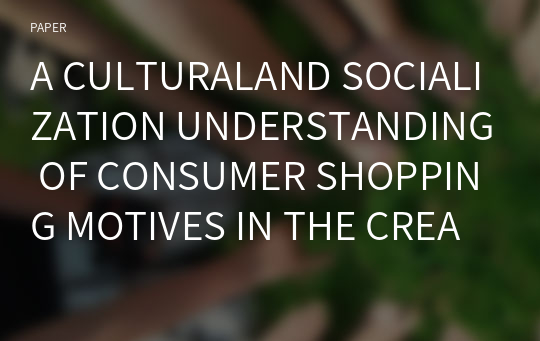A CULTURALAND SOCIALIZATION UNDERSTANDING OF CONSUMER SHOPPING MOTIVES IN THE CREATION OF STORE ATTACHMENT
* 본 문서는 배포용으로 복사 및 편집이 불가합니다.
서지정보
ㆍ발행기관 : 글로벌지식마케팅경영학회(GFMC)
ㆍ수록지정보 : GFMC Session1
ㆍ저자명 : Jong-Kuk Shin, MinKyung Moon, Min-Sook Park, Corey Allen Ross, Yong Ju
ㆍ저자명 : Jong-Kuk Shin, MinKyung Moon, Min-Sook Park, Corey Allen Ross, Yong Ju
영어 초록
Socialization agents are an important aspect of a consumer's tool set for determining how they interact with the market environment. These agents are traditionally thought to be members of one's family, peers, and mass media (Bush, Smith, and Martin 1999; John 1999). Research as shown how socialization agents play an important role in marketing research and how they affect attitude formation (Shin, Ross, and Moon, 2015) and brand/store switching behaviors (Shin, Park, and Ross, 2012). Culture defines social norms and forms what are acceptable or even desirable consumption goods within a society (Kaltcheva and Weitz, 2006). Through this definition, one can assume that culture likely has significant influences on a consumer’s shopping motives. Previous researches have attempted to divide culture into dimensions of vertical/horizontal and collectivism/individualism; where vertical individualism is made up of individuals who attempt to stand out from others in their uniqueness via competitive natures, a focus on success and achievements, and acquisition of power; horizontal individualism consists of individuals who tend to shun successful people as boasters and consider values of modesty respectable while retaining their individuality and personal goals apart from comparing to others around them; vertical collectivists are those who recognize a hierarchal form of society and seek to maintain the consistency of traditional authority structures within it; and horizontal collectivists hold views less related to hierarchal recognition and more related to values of equal cooperation with an honest and direct demeanor (Shavitt, Lalwani, Zhang, and Torelli, 2006; Kurman and Sriram, 2002; Triandris and Gelfland, 1998). However, the operational items utilized in research surveys, while successful in the west, such as in the U.S., have struggled to stand out and show significance in the Korean society. This research attempts to provide more useful survey items that embrace each aspect of culture type more clearly in order to reach levels of significance and distinction that are sorely needed in this field. In South Korea, which is thought to be a predominantly collectivist culture (Hofstede, 2001; Rhee, Uleman, and Lee, 1996), a study of discount shoppers found they are inclined to shop for the purpose of socialization either because they enjoy being in a crowd or to compare their current social status level with other shoppers in the same store (Jin and Kim, 2003). Collectivist consumers tend to shop with others among their social circles and spend more time shopping (Ackerman and Tellis, 2001). Consumers that spend more time shopping are more proactive in obtaining information while they are shopping (Bellenger and Korgaonkar, 1980). Risk averse shoppers attempt to increase their market knowledge (Mano and Elliott, 1997), and collectivists are thought to be more risk averse and attempt to avoid risk through various methods, such as price signaling (Shannon and Mandhachitara, 2008). In China, a largely collectivist society, consumers are quite price conscious and focused on thrifty spending habits (Kim, Forsythe, Gu, and Moon, 2002; Zhang, 2001; Weidenbaum, 1996), and they are more likely to engage in obtaining product information during shopping ventures than their individualist American counterparts (Ackerman and Tellis, 2001). Jin and Kim (2003) suggested that Korean shoppers are socially motivated to shop in order to compare their levels of accomplishments with other shoppers in the same venues. This falls in line with a competitive nature distinct in vertical culture types. Verticality in culture values is related to competition and moving up the social latter, while horizontal cultural values denote a more cooperative and passive stance on standing out (Triandis and Gelfand, 1998). It seems logical to assume that vertical culture values tend toward more hedonistic values rather than utilitarian. Utilitarian shoppers are more concerned about price competitiveness and convenience when shopping (Jin and Kim, 2003), implying that individuals of a horizontal cultural nature are more concerned with price comparison and the places that conveniently provide them with information needed to make purchase decisions in the store rather than through external information search, such as through social interactions. When shoppers lack socialization agents or collective cultures to help them make purchase decisions, they must turn to the stores themselves for assistance and information acquisition. Studies have shown that a lack of social interaction creates feelings of loneliness in elderly shoppers, whom will then turn to various mall shopping motivations, such as service consumption and diversion, in order to alleviate their loneliness (Kim, Kang, and Kim, 2005). This suggests that the shopping motivation to interact with service personnel in stores acts as a substitute for situations where socialization agents are lacking. Shopping malls have been shown to be help mitigate feelings of social isolation and emotional disconnect from society (Forman and Sriram, 1991; Mochis, 1996; Kang and Ridgway, 1996). As collectivists tend to highly desire social interactions for a variety of reasons, it is quite likely that such interactions will be a driving factor for their motivation to shop, especially when they lack the appropriate socialization agents that will provide the means to give such interactions outside of the market. Customer satisfaction leads customers to stronger emotional attachments to the stores they are satisfied with, implying that individuals form social bonds with the stores themselves; and this, in turn, increases the likelihood of these individuals becoming regular patrons (Shin and Park, 2014). There are a variety of shopping motives that have been used for studies in previous researches. In this research, we take a look at the motivations of social interaction (Tauber, 1972), information seeking (Bellenger and Korgaonkar, 1980), and price comparison (Groeppel-Klein, Thelen, and Antretter, 1999), and how they are affected by socialization agents, both personal and non-personal, as well as culture type and how they influence an individual's likelihood of emotional attachment to stores.참고 자료
없음"GFMC Session1"의 다른 논문
 FAST AND SLOW FASHION BRANDS IN DEVELOPING SUSTAINABLE ..6페이지
FAST AND SLOW FASHION BRANDS IN DEVELOPING SUSTAINABLE ..6페이지 “WHAT IF A CELEBRITY AND A BRAND CO-CREATE A NEW COLLEC..7페이지
“WHAT IF A CELEBRITY AND A BRAND CO-CREATE A NEW COLLEC..7페이지 THE INSTAGRAM’S STRATEGY IN ENGAGING THE CUSTOMER’S LOY..3페이지
THE INSTAGRAM’S STRATEGY IN ENGAGING THE CUSTOMER’S LOY..3페이지 THE PARTICULARITIES OF NEW PRODUCT DEVELOPMENT IN THE T..5페이지
THE PARTICULARITIES OF NEW PRODUCT DEVELOPMENT IN THE T..5페이지 THE LONE CHOCOLATE BAR: THE INFLUENCE OF PERCEIVED SCAR..6페이지
THE LONE CHOCOLATE BAR: THE INFLUENCE OF PERCEIVED SCAR..6페이지 ADS AS WORKS OF ART: MEASURING ADVERTISING IMMERSION3페이지
ADS AS WORKS OF ART: MEASURING ADVERTISING IMMERSION3페이지 ECONOMIES OF SMALL: NICHE STRATEGIES AND SUCCESS FACTOR..8페이지
ECONOMIES OF SMALL: NICHE STRATEGIES AND SUCCESS FACTOR..8페이지 THE INFLUENCE OF ONLINE CUSTOMER REVIEWS ON RETAILERS' ..6페이지
THE INFLUENCE OF ONLINE CUSTOMER REVIEWS ON RETAILERS' ..6페이지 IS THE ARTIFICATION PROCESS PERCEIVED BY FINAL CONSUMER..6페이지
IS THE ARTIFICATION PROCESS PERCEIVED BY FINAL CONSUMER..6페이지 THE ODD EVEN PRICE PARADOX IN THE FASHION LUXURY SECTOR6페이지
THE ODD EVEN PRICE PARADOX IN THE FASHION LUXURY SECTOR6페이지


























